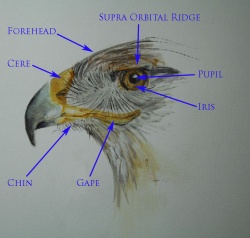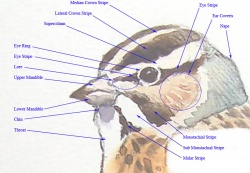(→Wings: added passerine wing) |
(→Heads: added text for passerine head) |
||
| Line 1: | Line 1: | ||
{{incomplete}} | {{incomplete}} | ||
==Heads== | ==Heads== | ||
| − | [[Image:Hawk head one.jpg|thumb| | + | [[Image:Hawk head one.jpg|thumb|250px|left|Artwork by {{user|colleenc|colleenc}}]] |
The picture illustrates a ferruginous hawk and shows several features common to most raptors. | The picture illustrates a ferruginous hawk and shows several features common to most raptors. | ||
| − | |||
The cere is the bare area surrounding the nostrils and can be different colours according to species, age and sex of the bird. | The cere is the bare area surrounding the nostrils and can be different colours according to species, age and sex of the bird. | ||
| − | |||
The gape is the edge of the mouth and is most obvious in very young birds. | The gape is the edge of the mouth and is most obvious in very young birds. | ||
| − | |||
The iris can also vary in colour according species, age and sex. | The iris can also vary in colour according species, age and sex. | ||
| − | |||
The forehead can vary in angle of slope, whilst the supra-orbital ridge is what gives some birds the threatening appearance. | The forehead can vary in angle of slope, whilst the supra-orbital ridge is what gives some birds the threatening appearance. | ||
| Line 29: | Line 25: | ||
| − | + | [[Image:Passerine_head_1.jpg|thumb|250px|left|Artwork by {{user|Tim+Wooton|Tim Wooton}}]] | |
| − | + | In this generalized passerine head you can see several features that may not all be distinguishable on a real bird. | |
| + | The crown stripes (median, lateral, supercilium and eye) and the cheek stripes (moustachial, sub-moustachial and malar) are shown in order to familiarize the reader with their relative positions, lots of birds will show only 1 or 2 of the stripes. | ||
| + | The two enclosed areas show the position of feather groups, which may or may not be different to the surrounding feathers, the lore is the area between the eye and beak whilst the ear coverts (also known as auricluars) are the feathers covering the ear opening. | ||
==Wings== | ==Wings== | ||
[[Image:Upperwing_1.jpg|thumb|350px|left|Artwork by {{user|Arthur+Bishop|Arthur Bishop}}]] | [[Image:Upperwing_1.jpg|thumb|350px|left|Artwork by {{user|Arthur+Bishop|Arthur Bishop}}]] | ||
[[Image:Passerine_wing_1.jpg|thumb|350px|right|Artwork by {{user|Tim+Wooton|Tim Wooton}}]] | [[Image:Passerine_wing_1.jpg|thumb|350px|right|Artwork by {{user|Tim+Wooton|Tim Wooton}}]] | ||
Revision as of 18:22, 19 August 2009
| This article is incomplete. This article is missing one or more sections. You can help the BirdForum Opus by expanding it. |
Heads

The picture illustrates a ferruginous hawk and shows several features common to most raptors. The cere is the bare area surrounding the nostrils and can be different colours according to species, age and sex of the bird. The gape is the edge of the mouth and is most obvious in very young birds. The iris can also vary in colour according species, age and sex. The forehead can vary in angle of slope, whilst the supra-orbital ridge is what gives some birds the threatening appearance.

In this generalized passerine head you can see several features that may not all be distinguishable on a real bird. The crown stripes (median, lateral, supercilium and eye) and the cheek stripes (moustachial, sub-moustachial and malar) are shown in order to familiarize the reader with their relative positions, lots of birds will show only 1 or 2 of the stripes. The two enclosed areas show the position of feather groups, which may or may not be different to the surrounding feathers, the lore is the area between the eye and beak whilst the ear coverts (also known as auricluars) are the feathers covering the ear opening.
Wings





